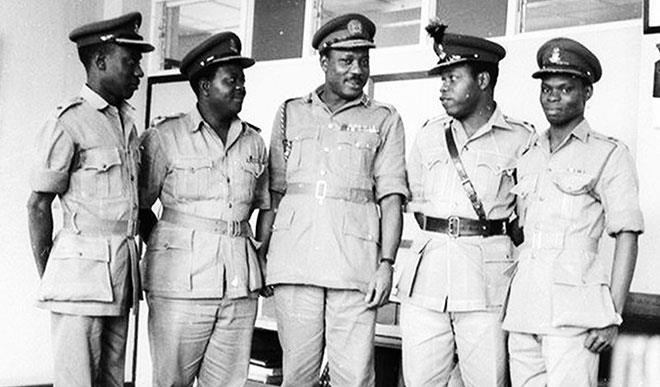British Secret Files On Nigeria’s First Bloody Coup, Path To Biafra
Then a comedy of errors took off that grounded the rebels and enhanced the failure of the Revolution. The general alarm in the Federal Guards barracks next door had been sounded. They had been disturbed by vehicle and troops movements up and down the barracks.

Two batches of NCOs had been turned out for alleged IS operations and some gunshots were heard in the proximity of the barracks. All soldiers were ordered by the head of NCOs, RSM Samuel Tayo to gear up and proceed to their various platoons. But according to military standard operating procedure, being NCOs, they needed an officer to give them commands. So the RSM led a platoon to their Officer Commanding’s(OC) residence at No 5 George Street, Ikoyi. But Okafor was not in. He was five streets away at Thompson Avenue searching for the Maimalari.
Then they headed to knock on Lt Ezedigbo – the second in command’s door at the block of flats at No 4 Lugard Avenue. He was not in too. He was part of the Revolution. So was the next in line Lt Igweze. Of all the five Federal Guard’s officers, only a very junior officer Lt Paul Tarfa was at home. Lt Joseph Osuma was not in too. He was not part of the assassins though; he had only gone out to sleep with a friend following Friday night’s festivities. If Tarfa later turned out to be somebody in his military career, it was because on that night of nights, he was present at home when the RSM arrived flustered looking for leadership. There had never been mutiny in the barracks before and so no one knew the standard procedural response.
According to his later account, Tarfa said he geared up in battle dress and was driven to the Federal Guards by the RSM’s convoy to take command. He was briefed on the situation and was told that most of the Igbo soldiers in the barracks could not be accounted for including the OC. Tarfa put the Federal Guards on a defensive alert like a cobra coiled to spring. He ordered sentries and machine guns emplaced on sandbag to be posted round the barracks walls. They made up and circulated a call out with its password “Black/Boy” so that dissent soldiers who were still coming in and out of the barracks could be identified and rounded up. Corporal Sarwuan, a Tiv rifleman became the victim of this coiled cobra. Seeing a soldier coming in from the dark, RSM Tayo challenged,
‘Friend.’ Sarwuan was said to have replied.
‘Advance to be recognised.’ Tayo ordered and called out “Black.”
But Sarwuan did not respond and continued to advance. Tayo called out again, “Black.” No response. The RSM’s finger twitched in the trigger guard and his heart beat faster and faster. Tayo for the third and last time called out “Black.” But Sarwuan kept advancing without replying. He had forgotten the password and Tayo concluded he was an enemy. He squeezed the trigger plunging Sarwuan’s wife and children into sadness of incomprehensive depths. Major Adegoke, who took over from Ifeajuna as the DA and QMG at 1st Brigade in Kaduna was similarly killed in 4th battalion in Ibadan having been mistaken for a mutineer/enemy. He was holidaying in his native home when he heard about the coup; he hastened to the barracks for more information only to be handed his death. Black/Boy. His Boy did not follow Black and Adegoke met his death.
That night, Tarfa who had assumed the command of the Federal Guards went to the OC’s office adjacent to his. In a file in the cabinet, he saw planning documents, operations orders and a recent signal note from Nzeogwu which read: “Ensure the Tiger is in the net. Even if recruiting more captains.” The tiger he later understood was Maimalari; the net was his death. The extra captain they managed to recruit was Adeleke who only knew of the plot hours earlier at the Apapa residence of Ifeajuna after being brought by Major Ademoyega before some departed for the cocktail. Adeleke at first refused and was told that if the Revolution to free Nigeria started and he was not with it, he would regret it maybe not that day, maybe not the following day, but soon, and for the rest of his life. He fell in enthusiastically. At around quarter past four, Adeleke was with Ademoyega at the Officers Mess when Okafor came to report that he had just lost his command; that the Federal Guards were no longer responding to his orders, that in fact they almost shot him when he went back to the barracks to mobilise more troops. The only infantry force on which much had hinged and much of the second stage would hinge was no longer with the Revolution. What had happened?
When Okafor’s lieutenants roused the NCOs for the assignment, they were told they were needed for an IS operation. They were expecting to be taken outside Lagos to crush one of the hotspot of the Western Region’s crisis or to Mushin to quell a riot as they had done three weeks before. Instead they were taken to Brigadier Maimalari’s residence and they saw his guard commander and another soldier shot dead. The guard commander was known to them. They lived in the same quarters at the barracks. They had started to doubt whether they were truly on IS operation. Again, they were ordered not give the Brigadier a chance to surrender; they were ordered to shoot him dead on sight by Okafor, a disgraced thief and a liar pardoned by the same Maimalari they were asked to kill. They concluded that this was not an IS operation; this was an assassination squad they were forced to join. The final straw came when Ademoyega arrived to tell them that Maimalari had been found and shot by Ifeajuna. His corpse laid at the Mess. It was a terrible blow to the NCOs. Okafor was relieved to hear the news and ordered his second in command Captain Oji with four NCOs to proceed to check the situation at Airport Junction in Ikeja. The remaining men were ordered to proceed to Mess for further instruction. Instead, they rebelled, passed the Mess to the barracks and threatened to shoot Okafor if he tried to give them orders anymore. It was righteous mutiny within an unholy mutiny.
According to the testimony Ifeajuna later gave after his arrest a month later, he saw the GOC’s official car and his guards driving past the entrance of the barracks. This made them conclude that it was the GOC that had roused the soldiers and placed the barracks on a defensive alert. As envisaged, the Revolution was not meant to be a one-night stand. They had anticipated that at one point, soldiers still loyal to the Nigerian Army would wake up and fight them. That was why in the first place they decided to kill off all the senior officers that will command the loyal troops. In addition, that was also why immediately Nzeogwu finished off Sarduana up North, he went to take over Brigadier Ademulegun’s office at the Brigade. Knowing that the Brigadier or his deputy would not come back, the revolutionaries had expected that the shock of seeing all the senior officers dead was enough to sag the morale of the loyal soldiers to fight back. Furthermore, Ifeajuna had planned for a further arms advantage: The firepower of the Southern brigade was in Abeokuta with the 2nd Recce Squadron and the field artillery battery. Their officer commanding, Major Obienu was a central plank of the Revolution. He was supposed to mobilise his armoured, mechanised and artillery support: all the ferrets, the scot cars, 105mm Howitzers and assemble at the airport junction in Ikeja. A unit from the Revolution high command set up at the Federal Guards Mess was supposed to go to Ikeja bring this armoured squadron into Lagos and position them menacingly in front of the barracks and other military installations to neutralise any threat to the Revolution.




